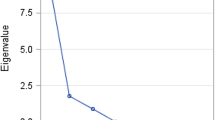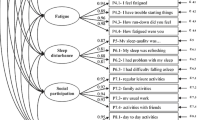Abstract
Purpose
The Patient-Reported Outcomes Measurement Information System 29-item profile (PROMIS-29 v2.0), which measures health-related quality of life (HRQoL), has had limited evaluation among older adults (age 65+) with multiple chronic conditions. Our purpose was to establish convergent validity for PROMIS-29 in this population.
Methods
We collected the PROMIS-29 v2.0 and the Veterans RAND 36 (VR-36) for 1359 primary care patients aged 65 + with at least 2 of 13 chronic conditions, oversampling those aged 80+. We conducted multiple analyses to examine score differences across subgroups, differential item functioning (DIF), and comparisons of PROMIS-29 v2.0 and VR-36 scores.
Results
The mean age was 80.7, and all patients had at least 2 of 13 chronic conditions. Older age, female sex, Hispanic ethnicity, and more chronic conditions were associated with worse physical health scores (PHS) and mental health scores (MHS) on the PROMIS-29 v2.0—findings which are in the expected direction. None of the 700 pairs of items met criteria for DIF. PHS and MHS were highly intercorrelated (r = 0.74, p < 0.001 for this and all other findings). PHS was more highly correlated with the VR-36 Physical Component Score (PCS) than the Mental Component Score (MCS) (r = 0.85 and 0.32, respectively), while MHS was highly correlated with both (r = 0.70 and 0.64, respectively).
Conclusions
PROMIS-29 v2.0 demonstrates expected bivariate relationships with key person-level characteristics and does not show DIF. PROMIS-29 v2.0 scores are highly correlated with VR-36 scores. These results provide support for the validity of PROMIS-29 v2.0 as a measure of HRQoL among older adults with multiple chronic conditions.
Similar content being viewed by others
References
HealthMeasures. PROMIS.
Cella, D., et al. (2010). The Patient-Reported Outcomes Measurement Information System (PROMIS) developed and tested its first wave of adult self-reported health outcome item banks: 2005–2008. Journal of Clinical Epidemiology, 63(11), 1179–1194.
Hinchcliff, M., et al. (2011). Validity of two new patient-reported outcome measures in systemic sclerosis: Patient-reported outcomes measurement information system 29-item health profile and functional assessment of chronic illness therapy-dyspnea short form. Arthritis Care & Research (Hoboken), 63(11), 1620–1628.
Alcantara, J., Ohm, J., & Alcantara, J. (2016). The use of PROMIS and the RAND VSQ9 in chiropractic patients receiving care with the Webster Technique. Complementary Therapies in Clinical Practice, 23, 110–116.
Beaumont, J. L., et al. (2012). Comparison of health-related quality of life in patients with neuroendocrine tumors with quality of life in the general US population. Pancreas, 41(3), 461–466.
Pearman, T. P., et al. (2016). Health-related quality of life in patients with neuroendocrine tumors: an investigation of treatment type, disease status, and symptom burden. Supportive Care in Cancer, 24(9), 3695–3703.
IsHak, W. W., et al. (2017). Patient-reported outcomes of quality of life, functioning, and GI/Psychiatric symptom severity in patients with inflammatory bowel disease (IBD). Inflammatory Bowel Disease, 23(5), 798–803.
Katz, P., Pedro, S., & Michaud, K. (2016) Performance of the PROMIS 29-item profile in rheumatoid arthritis, osteoarthritis, fibromyalgia, and systemic lupus erythematosus. Arthritis Care & Research (Hoboken).
Lai, J. S., et al. (2017). An evaluation of health-related quality of life in patients with systemic lupus erythematosus using PROMIS and Neuro-QoL. Clinical Rheumatology, 36(3), 555–562.
Schnall, R., et al. (2017). A health-related quality-of-life measure for use in patients with HIV: A validation study. AIDS Patient Care STDS, 31(2), 43–48.
Ware, J. E. Jr., & Sherbourne, C. D. (1992). The MOS 36-item short-form health survey (SF-36). I. Conceptual framework and item selection. Medical Care, 30(6), 473–483.
Hays, R. D., et al., PROMIS-29 v.2.0 Profile physical and mental health summary scores. Quality of Life Research. Epub ahead of print. https://doi.org/10.1007/s11136-018-1842-3.
Kazis, L. E., et al. (2004). Improving the response choices on the veterans SF-36 health survey role functioning scales: Results from the Veterans Health Study. Journal of Ambulatory Care Management, 27(3), 263–280.
Tarlov, A. R., et al. (1989). The medical outcomes study: An application of methods for monitoring the results of medical care. JAMA, 262(7), 925–930.
Goldberg, J., et al. (2014). The association of PTSD with physical and mental health functioning and disability (VA Cooperative Study #569: the course and consequences of posttraumatic stress disorder in Vietnam-era veteran twins). Quality of Life Research, 23(5), 1579–1591.
Bishawi, M., et al. (2013). Changes in health-related quality of life in off-pump versus on-pump cardiac surgery: Veterans Affairs Randomized On/Off Bypass trial. The Annals of Thoracic Surgery, 95(6), 1946–1951.
Turner, A. P., Kivlahan, D. R., & Haselkorn, J. K. (2009). Exercise and quality of life among people with multiple sclerosis: Looking beyond physical functioning to mental health and participation in life. Archives of Physical Medicine and Rehabilitation, 90(3), 420–428.
NCQA. (2006) HEDIS 2006 Specifications for the Medicare Health Outcomes Survey. Volume 6. National Committee for Quality Assurance.
Krieger, N., et al. (2005). Painting a truer picture of US socioeconomic and racial/ethnic health inequalities: The Public Health Disparities Geocoding Project. American Journal of Public Health, 95(2), 312–323.
Gelin, M. N., & Zumbo, B. D. (2003). Differential item functioning results may change depending on how an item is scored: An illustration with the Center for Epidemiologic Studies Depression Scale. Educational and Psychological Measurement, 63(1), 65–74.
Benjamini, Y., & Hochberg, Y. (1995) Controlling the false discovery rate: A practical and powerful approach to multiple testing. Journal of the Royal Statistical Society. Series B (Methodological), 57(1), 289–300.
Bindman, A. B., Keane, D., & Lurie, N. (1990). Measuring health changes among severely ill patients. The floor phenomenon. Medical Care, 28(12), 1142–1152.
Selim, A. J., et al. (2004). The health status of elderly veteran enrollees in the Veterans Health Administration. Journal of the American Geriatrics Society, 52(8), 1271–1276.
Cohen, J. (1988). Statistical power analysis for the behavioral sciences (2 edn.). Hillsdale: Lawrence Erlbaum Associates.
Rogers, W. H., et al. (2004). Comparing the health status of VA and non-VA ambulatory patients: The veterans’ health and medical outcomes studies. The Journal of Ambulatory Care Management, 27(3), 249–262.
Farivar, S. S., Cunningham, W. E., & Hays, R. D. (2007) Correlated physical and mental health summary scores for the SF-36 and SF-12 health survey, V. 1. Health and Quality of Life Outcomes, 5, 18.
Taft, C., Karlsson, J., & Sullivan, M. (2001). Do SF-36 summary component scores accurately summarize subscale scores? Quality of Life Research, 10(5), 395–404.
Simon, G. E., et al. (1998). SF-36 summary scores: Are physical and mental health truly distinct? Medical Care, 36(4), 567–572.
Craig, B. M., et al. (2014). US valuation of health outcomes measured using the PROMIS-29. Value in Health, 17(8), 846–853.
Hanmer, J., et al. (2017). Selection of key health domains from PROMIS for a generic preference-based scoring system. Quality of Life Research, 26(12), 3377–3385.
Hanmer, J., et al. (2015). The PROMIS of QALYs. Health and Quality of Life Outcomes, 13, 122.
Krosnick, J. A. (1999). Survey research. Annual Review of Psychology, 50(1), 537–567.
Rogelberg, S. G., & Stanton, J. M. (2007). Introduction. Organizational Research Methods, 10(2), 195–209.
Funding
Funded by the National Institute on Aging (contract #HHSN271201500064C NIH NIA, PI: Edelen). The funder had no role in data collection, data analysis, interpretation, manuscript drafting, manuscript revision, or decision to submit for publication.
Author information
Authors and Affiliations
Corresponding author
Ethics declarations
Conflict of interest
The authors declare that they have no relevant conflicts of interest.
Ethical standards
The authors declare that this study was conducted in accordance with appropriate ethical standards for research, including the Declaration of Helsinki. The study was approved by the RAND Human Subjects Research Protection Committee (Study #2015-0956-AM05), and by the Kaiser Permanente Colorado IRB (IRB Number CO-15-2199).
Informed consent
Participants provided informed consent, with a waiver of documentation of informed consent.
Electronic supplementary material
Below is the link to the electronic supplementary material.
Rights and permissions
About this article
Cite this article
Rose, A.J., Bayliss, E., Huang, W. et al. Evaluating the PROMIS-29 v2.0 for use among older adults with multiple chronic conditions. Qual Life Res 27, 2935–2944 (2018). https://doi.org/10.1007/s11136-018-1958-5
Accepted:
Published:
Issue Date:
DOI: https://doi.org/10.1007/s11136-018-1958-5




